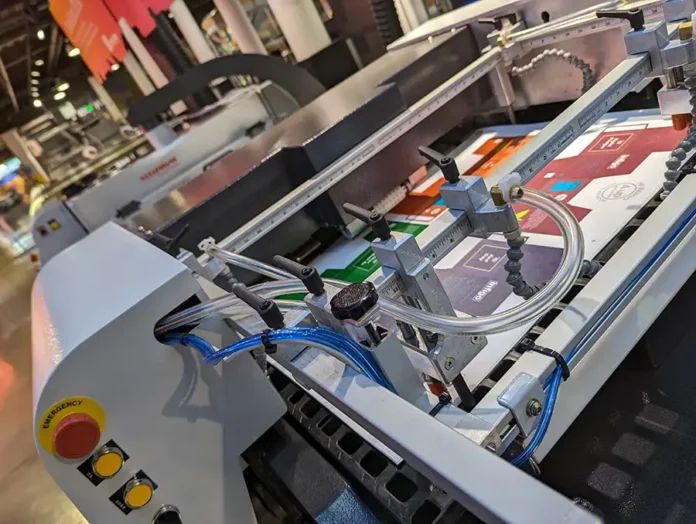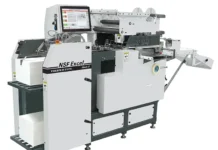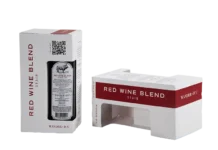
Edited by Erin La Row, editor, PostPress
Offline UV coating continues to be a popular choice for many print applications. Although UV can be applied inline, there are still situations where offline is the best solution. It is especially important for specialty UV coating applications where soft-touch, glitter and textured finishes are used.
PostPress magazine talked to Chris Hogge, director of sales and business development at Harris & Bruno; Ryan Moskun, marketing manager at Harris & Bruno; Andrew Brooks, coatings business development manager for paper-based packaging at Sun Chemical; and Glenn Webster, technical manager, functional materials applications at Sun Chemical, about best practices for offline UV coating.
What important questions need to be asked to decrease press challenges before a print job is coated on an offline UV coater?
Hogge and Moskun: What type of media is the printing/coating on, and what is the post-print dyne level of that piece? This consistently is a challenge in digital printing and proceeding into post-coating operations. If a printed image has a low dyne level, it makes it much more challenging to uniformly coat for protective or decorative effects.
Brooks and Webster: It is important that the surface being printed on is receptive to UV coating. Most traditional print inks will do fine, but other UV coatings (previously applied), some digital prints and specialty substrates can be problematic for offline UV coatings due to the blooming of migratory surfactants and additives that change the surface energy of the post-dried inks.
Are there recent developments with UV coatings in the processes of offline UV coating?
Hogge and Moskun: One of the biggest game changers for coating was the chamber-anilox system, which is very different from the traditional roller-coater. Where a roller-coater constantly has to be adjusted to keep the coating even, a chamber-anilox system is perfectly metered every time, so the 1,000th sheet will come out just as smooth as the first.
Additionally, a chamber-anilox system easily can accommodate particulates such as glitter, grit and soft touch with a smooth, even laydown. This was a huge leap over the roller-coater systems, which tend to have all of the particulates collect in the nip and end up never transferring to the page. Embellishments have been a big topic and will continue to be. People want to build off haptics and tactile feel for added response and enhanced print engagement with their customers.
Brooks and Webster: The offline UV market is stable for traditional printing. There, of course, always are changes in viscosity, cure and regulatory needs, but this goes for both offline and inline UV coating.
There always is a need to improve UV coatings adhesion on difficult substrates. As digital printing evolves and synthetic substrates advance, there is a need for UV coatings to evolve to meet these needs.
Are there different UV coating formulations for different printing processes, inks and substrates?
Hogge and Moskun: Absolutely, especially in the digital print industry where inks between presses can be so different. AQ inkjet, UV inkjet, dry toner and liquid toner all present challenges to post-print solutions like coating and finishing, and need to be understood for the overall solution to be successful. Media also has an impact on that. Having the right coating for the right job is important so that all desired properties are achieved. Knowing the dyne level of a substrate also helps determine the best course of action for preparing sheets for coating.
Brooks and Webster: The standard UV coatings used in offline UV coaters are gloss, matte, satin and glueable/stampables. Formulations can change to match the ideal viscosity and cure of offline coaters. Questions should be asked to fully understand both the pumping and curing of any offline coater. We have seen people select an offline coater as a “hardware option” but never consider which UV coating they are planning to use for their application. Many offline coaters have shorter deliveries or less wattage on the cure lamps than traditional presses. It is best to get a UV coating designed or at least compatible with smaller deliveries.
Another question to ask is how much coating can be applied and whether it can be adjusted. The rule of thumb we’ve always used is that most offline coaters apply a coating weight around 3 lbs/ream, equal to about a 12-14 bcm anilox. It is good to find out how much coating the offline coater being considered will apply.
Finally, it is best to ask about the three options we’ve seen on offline coaters which make the most impact: 1) Preheat zone – Preheat can help a UV coating flow out better for a smoother finish, and liquify wax in digital ink to improve adhesion of the UV coating. 2) Anilox – Some offline coaters do have the ability to use an anilox. Anilox can provide more consistent coating thickness and allow the amount of coating applied to change. 3) Staging both infeed and outfeed – This is not so much coating related, but we have known many people who wished they did a better job picking the infeed and outfeed option on their offline coater.
Are there specialty UV coatings available for offline flood UV other than gloss?
Hogge and Moskun: Yes, there are several different styles of UV coating. Each unique coating can help convey a message, brand, enhance depth of print, as well as evoke senses such as smell or touch. Using a specialty finish to enhance print has shown to draw more attention and increase engagement. Some examples of specialty finishes are soft touch, grit, pearlescent, color shift, matte, satin, glitter and reticulation. Many of these special effects are great for lamination replacement and far more cost effective. As previously mentioned, many of these finishes are not obtainable with roller-coater systems, as their particulates do not properly transfer to the substrates. A chamber-anilox system is a much better choice for these types of applications.
Is UV LED technology being used in offline UV or are most offline coating applications using more conventional UV drying technology?
Hogge and Moskun: There has been a slow adoption to LED in offline UV technology. The primary limitation is the LED coatings market is not as mature as traditional AQ or UV coatings, thus the offerings and end market is not as vast. That could change in the future and with more development demand.
Brooks and Webster: We have not seen LED offline coaters, but that does not mean they do not exist. One of the problems that we see with LED in offline coating is that the radiant infrared heat of a UV bulb sometimes helps UV coatings flow out better. LED has much less heat. We have seen people struggle with an LED-curable coating that flows out well to a nice glassy finish that most people like. The other concern is that often LED coatings will cure with ambient room light. If installing an LED offline coater, it is best to plan for “light management” to make the process easier. With these exceptions, there is no reason that LED coatings cannot be installed in an LED offline coater, but we have not seen many people asking for this yet.
What are advantages of UV coating sheets offline vs. inline?
Hogge and Moskun: Most printers feature multiple devices, which can be expensive or inefficient to have inline with their current offset or digital print processes. Specialty coatings may require additional set-up time, which is more easily done offline than inline. On the flip side, coating inline can greatly speed up the coating and finishing process, especially when running applications like gloss, matte and soft touch.
Brooks and Webster: Most of the people we see who get an offline coater do it for these reasons:
- Cost. They have a conventional/water-based press and they do not want to invest in a UV curing module or a new press. Offline coaters allow them to meet their customers’ needs for a UV coating at a fraction of the cost.
- Ease of use. Most of the offline coaters are simple to use. Producers can turn the system on, run a few hundred sheets and go home. They are consistent, easy to use, designed to be easy to clean and, overall, they are much simpler to use than a full press set-up.
- Ease of trouble shooting. We cannot say how many times customers have contacted us looking for help with ink scratching off a sheet. We tell them if they have an offline coater, turn off the coating unit and run the sheet under the lamp a few times. This faux ages the sheet and easily will tell producers if they have a cure or drying issue. Of course, troubleshooting like this would not justify an offline coater, but it can be a useful troubleshooting tool.
What segments of the printing industry have seen the most growth for offline UV coating?
Hogge and Moskun: Definitely, digital print. There has been a plethora of offline coating products that have been used for coating protection or embellishments. The nice thing about the shorter runs is that printers and brands can experiment with different finishes and see what works best for their piece. Additionally, being able to have different finishes on the same product can help reach a broad audience, with consumers selecting the finish that most speaks to them. For example, a brand may choose a product of various prints, and then match a coating to the print (i.e., glitter, soft touch, etc.), creating a unique customer experience.
Brooks and Webster: Commercial printing seems to be the predominant user, with the digital segment being the fastest growing. There still are some applications, though, in the packaging sector.
PostPress would like to thank Chris Hogge and Ryan Moskun at Harris & Bruno International, and Andrew Brooks and Glenn Webster at Sun Chemical, for their assistance with this article. Learn more about Harris & Bruno at www.harris-bruno.com and Sun Chemical at www.sunchemical.com.




